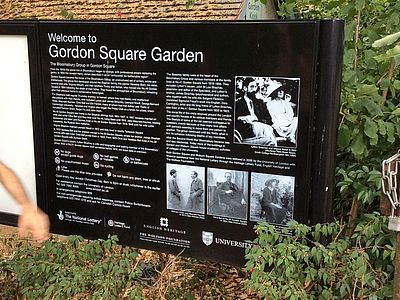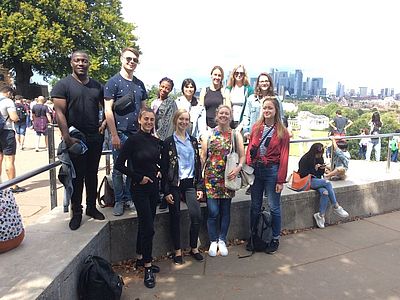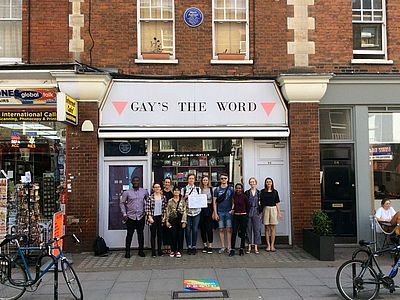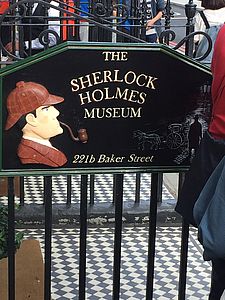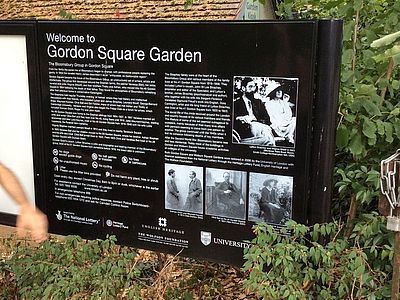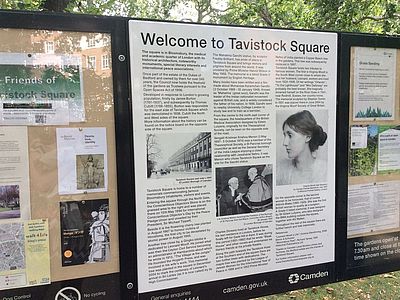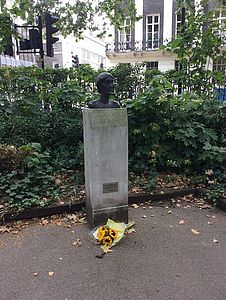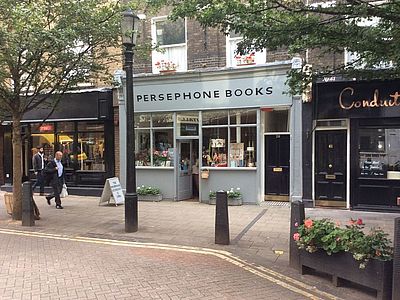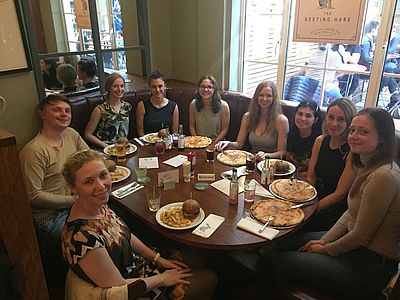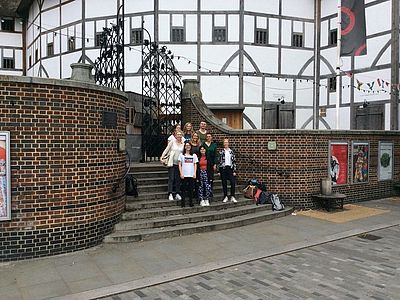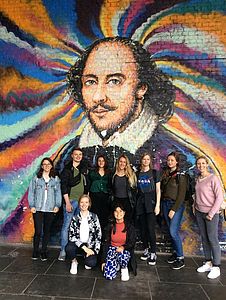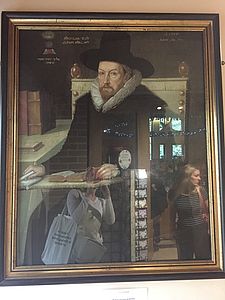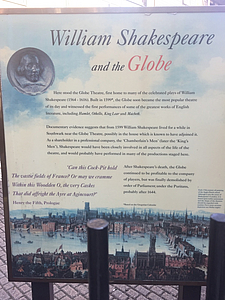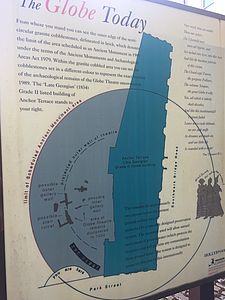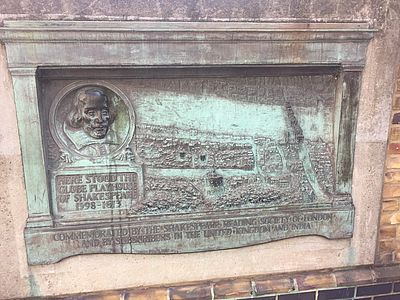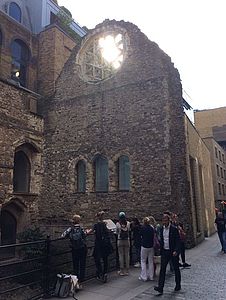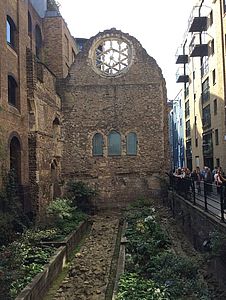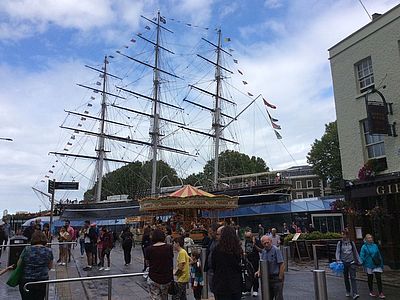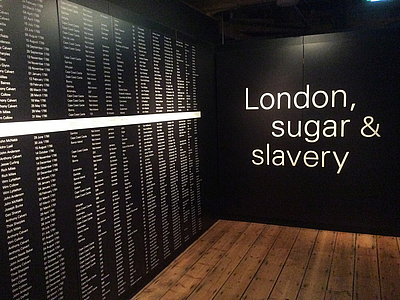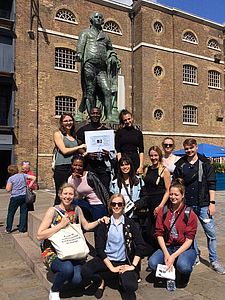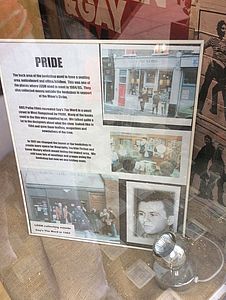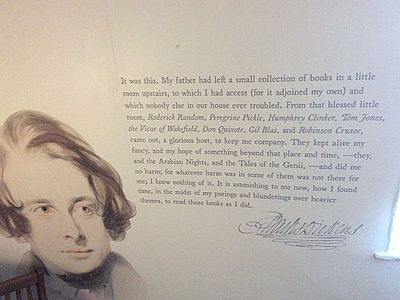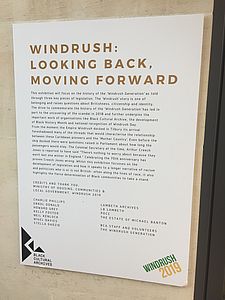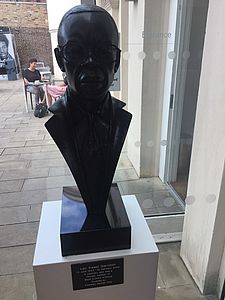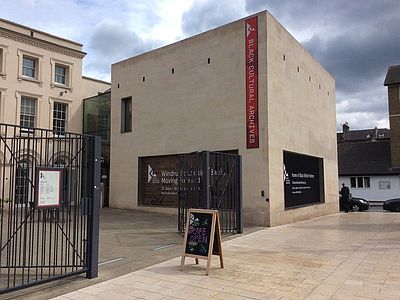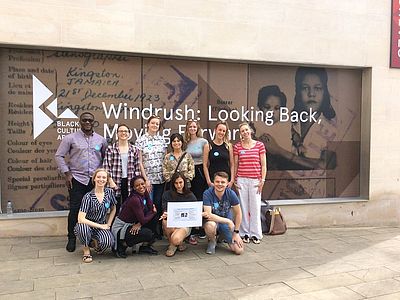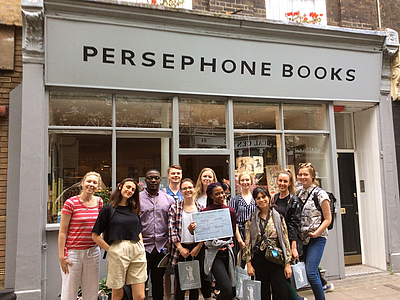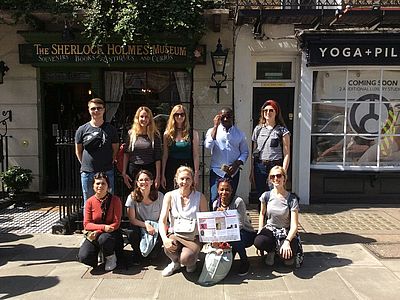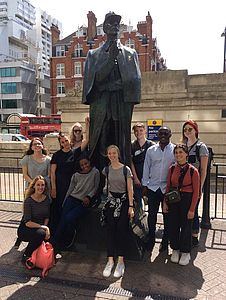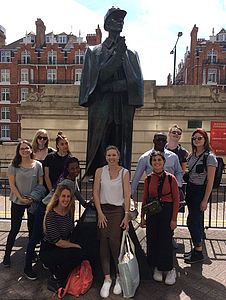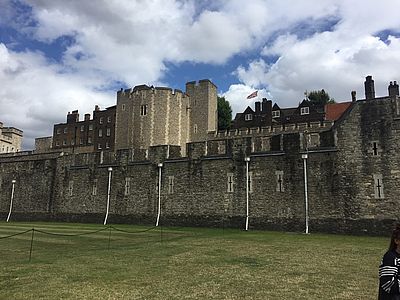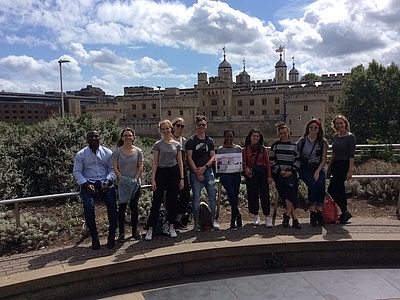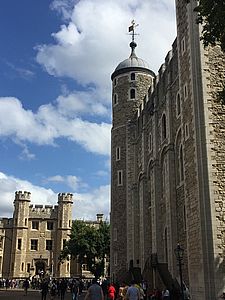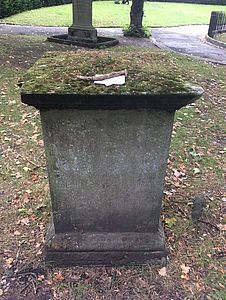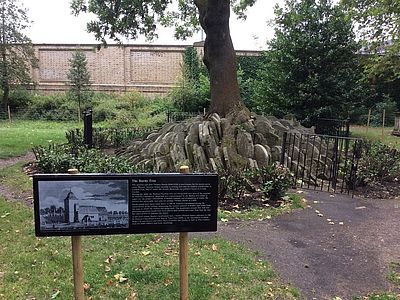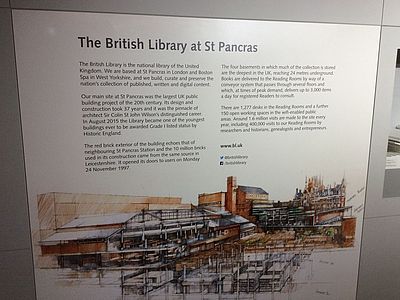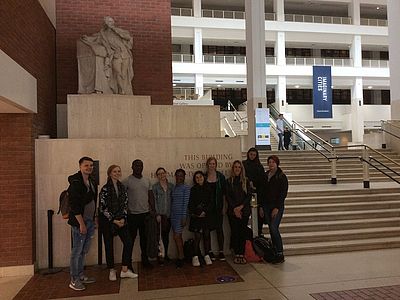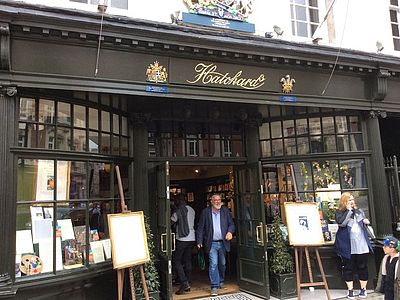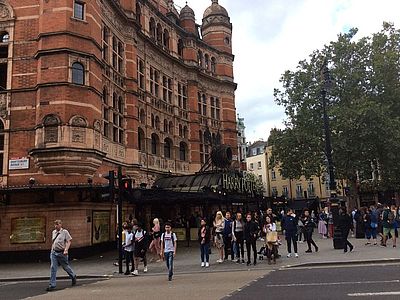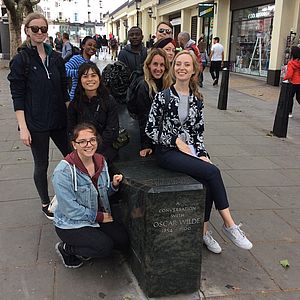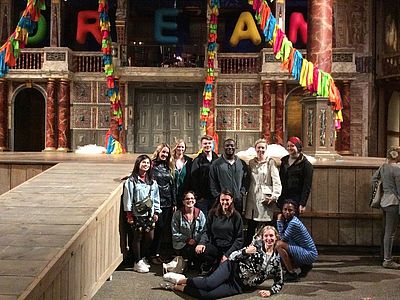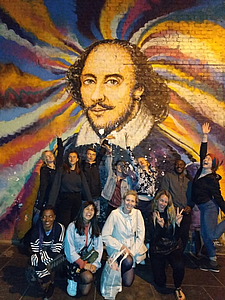Excursion 2019 “Literary London”
Overview 2019
Written by Darleen Helms and Nadine Schmidt
The 2019 excursion “Literary London” (5 August - 12 August) continued a long-standing tradition of London trips at the University of Bremen. On the day of the arrival, we checked into our accommodation at the London School of Economics. Afterwards, we received a tour by Jason Andrews that led us through Gordon Square Garden, Brunswick Square Garden and Tavistock Square. During this, we were educated on the members of the famous Bloomsbury Group. Then, it was time for our very first dinner in London - our welcome dinner. This was just the beginning of an eventful journey through the rich history of the city.
The very first full excursion day began with a lecture by Dr. Tristan Marshall at Shakespeare’s Globe Theatre, combined with a tour of the theatre. The tour was followed by a workshop led by actor-director Emma Gersch, who taught us the major aspects of plays on stage, which are Action, Audience, Architecture. In his context, we were tasked with playing out scenes from Shakespeare’s A Midsummer Night’sDream. Later that day, our group participated in a Southwark walking tour, where we visited the landmarks of Shakespeare’s London. We saw Southwark Cathedral, The Clink, and Winchester Palace, as well as the original sites of the Globe Theatre and the Rose Playhouse, before we went back to our accommodations.
Our first stop on Wednesday was Westminster Bridge. There, we read out the poem “Composed Upon Westminster Bridge, September 3, 1802” by William Wordsworth and immersed ourselves in the creation of Wordsworth’s art. This was followed by a boat trip along the Thames to Greenwich. We were accompanied by a tour guide, who pointed out and explained the historical sights along the way. Upon arriving in Greenwich, we visited the National Maritime Museum and the Royal Observatory. By following an original Victorian foot tunnel, our group reached the Museum of London Docklands, where we dived deeper into London’s imperial past and postcolonial present. After the guided tour in the museum, we journeyed to the National Theatre and watched the play Small Island. The play is based on a novel that we read in the seminar.
On Thursday, our group visited the bookshop Gay’s The Word. There, we were able to learn more about the shop’s history and its exclusively LGBTQ+ related content. Additionally, we used our stay in order to fill our bags with books. The next stop was at the Charles Dickens Museum, which is at the same place he stayed at when he was in London. After exploring the house and reading some of his original letters, we took the tube to Brixton and visited the Black Cultural Archives. There, we learned more about the history of the Windrush Generation and the Windrush scandal in 2018. Our last stop of the day was at Persephone Books, which is a bookshop and publishing house that focuses on re-publishing books written by female authors in the 20th century.
Friday, the fifth day of our excursion, provided an opportunity to explore the exciting world of “London and Crime”. In the morning, we visited the Sherlock Holmes Museum located at 221b Baker Street – the actual address of Arthur Conan Doyle’s famous fictional detective. Here, we were offered a glimpse of the late Victorian Era as it is portrayed in Doyle’s stories, ranging from Holmes’ intricately furnished study to treatises on the different types of cigarette ash. After a walking tour of Baker Street and a quick lunch, we took the underground to Tower Hill and spent the following three hours at the Tower of London. During our guided tour, we were treated to a variety of gruesome anecdotes relating to the prison and its past inmates, among which are Queen Elizabeth I and two of Henry VIII’s wives. Afterwards, we continued our exploration individually, and concluded our day with a leisurely evening in the city.
We began Saturday, the second-to-last day of our trip, with a visit to St Pancras Church and Cemetery, where many well-known literary figures such as Mary Wollstonecraft and her daughter Mary Shelley are buried. Following this, we took a tour of the British Library, which holds historically significant artefacts such as the Magna Carta and Shakespeare’s First Folio. After lunch, we moved on to central London and, starting on Oxford Street, walked a while in the footsteps of Mrs Dalloway, the heroine of Virginia Woolf’s 1925 novel. We passed Fortnum and Mason as well as Hatchard’s, two old-established stores, took a turn around Piccadilly Circus and explored Shaftesbury Avenue. This led us to the West End with its famous theatres and landmarks such as Drury Lane, the Theatre Royal, and the Lyceum Theatre. Thus, steeped in 400 years of British theatre culture, we were well-prepared for the evening’s entertainment: William Shakespeare’s A Midsummer Night’s Dream at the Globe Theatre.
Sunday, the last day of our excursion, was dedicated to “The Long 18th Century”. In the morning, we wandered the beautiful halls and gardens of Kenwood House in Hampstead, which is known for its neoclassical architecture. Our guided tour introduced us to the history of the villa and its 18th-century owner, William Murray, who was a crucial figure in helping to prepare a path for the abolition of the slave trade. As it was our final day in London, we were free to explore the city during the afternoon, relaxing along the Thames or doing some last-minute book shopping. In the evening, we ended our trip with a round of non-alcoholic farewell drinks, and on Monday morning parted ways to return to Bremen.
All in all, the London excursion once again proved a great success with the students. It offered them an opportunity to practise their language skills intensively in an English-speaking environment while also deepening their knowledge of the manifold literary periods and historical movements they are introduced to during their studies. By attending lectures of British experts in the field as well as by immersing themselves in the day-to-day life of Shakespearean times through acting workshops and seeing the bard’s plays performed on stage, the students were able to gain hands-on experience with the texts and interact with British history on a level that goes beyond the confines of the classroom. This made the trip an unforgettable time for everyone involved.
Monday, 5 August 2019: Arrival
Morning: Arrival in London
3 PM: Check-in at London School of Economics (Passfield Hall Accommodation)
4 - 6 PM: Bloomsbury Walking Tour
6 PM: Welcome Dinner
Student Report, written by Robin Braun: Bloomsbury Walking Tour
On our first excursion day, Jason Andrews met us at our accommodation, the LSE Passfield Hall, to take us on a walking tour. It focussed on literary creators that lived in London — especially, but not exclusively, the Bloomsbury group. Around Gordon Square Garden, Brunswick Square Garden and Tavistock Square, Jason introduced us to some of the well-known members which formed this intellectual and influential group in the first half of the 20th century. We learned about their important contributions to art and literature as well as their complex and sometimes confusing relationships, reflecting their liberal and non-conform lifestyles that stood in contrast to contemporary social norms. We passed Russell Square and Senate House, where George Orwell’s job at the Ministry of Information inspired him to write 1984. Not far from there, we followed the footsteps of Vladimir Lenin and Karl Marx on the route they took to the British Library in their days. Another stop was at the Charles Dickens Museum, which is located at the very house the writer lived in almost 200 years ago. Lastly, Jason showed us two bookshops called Gay’s the Wordand Persephone, which we went to explore in more detail on Thursday.
(Slightly edited by Darleen Helms and Nadine Schmidt for publication purposes.)
Tuesday, 6 August 2019: Shakespeare’s London
8.15 AM: Departure for Shakespeare’s Globe Theatre
9.15 - 11.15 AM: Shakespeare’s Globe: “Understanding the Theatre Spaces” - Lecture with Higher Education Faculty, which included a tour of the theatre
11.30 AM - 1.45 PM: “Globe Performance Practice: A Midsummer Night’s Dream” Workshop with Higher Education Faculty
1.30 - 2.30 PM: Lunch at Borough Market
3 - 5.30 PM: Southwark Walking Tour: Shakespeare’s London (Southwark Cathedral, The Clink, Winchester Palace, Globe original site, Rose Playhouse site) - back to LSE via Waterloo Station / South Bank Centre
Student Report, written by Nadine Schumann: Globe Theatre & Workshop
On the second day of our London excursion, we explored Shakespeare’s Globe Theatre. We started the day with a lecture by Dr. Tristan Marshall with whom we then toured the empty theatre space. Through his description we were able to imagine what it must have been like to be in the audience back in the Elizabethan age. We learned about the importance of the theatre for the people of that time and also about the status of women on stage. Interestingly, the audience did not only attend the play for enjoyment. The Globe Theatre was also a meeting point where rich people showed off their wealth and poor people enjoyed talking to each other. In fact, people with higher prestige tended to sit right next to the stage because it was the best place to catch attention. The people with lower economic status usually stood right in front of the stage because it was much cheaper there.
In our practical Globe workshop, we had the honour of working with Emma Gersch, an actor-director who worked at nationally acclaimed playhouses like Shakespeare’s Globe Theatre and Minack Theatre in Cornwall. Based on her experience and knowledge, we firstly talked about the three A’s (Action, Audience, Architecture) which are relevant to all aspects of performance. In order to understand a play and to fully enjoy it, the audience needs some interest, imagination and stamina. In terms of action, we experienced the importance of space for a play by walking through the room in different movements and variations. By doing so, we realised that the use of space has a substantial effect on the perception of a play. In this context, we had the task to act out in groups of two a short scene from Shakespeare’s AMidsummer Night’s Dream – the play we were going to watch performed on Saturday. It was quite interesting to see how each group had a different approach to the scene. What I became aware of during the workshop at Shakespeare’s Globe was the fact that every Shakespearean drama can be interpreted differently according to the way it is staged, even though the overall message of the play may stay the same. If there are actors and actresses dressed in modern costumes and accompanied by contemporary music rather than in a traditional way, the effect on the audience is different.
(Slightly edited by Darleen Helms and Nadine Schmidt for publication purposes.)
Wednesday, 7 August: London’s Imperial Past and Postcolonial Present
9 - 10 AM: Upon Westminster Bridge (Long 18th century)
10 - 11 AM: Thames boat trip to Greenwich Village
11 AM - 2 PM: Greenwich (The Maritime Museum, Observatory, Victoria Footwalk)
2 - 3 PM: Lunch
3 - 5.30 PM: The Museum of London Docklands (guided tour; Sugar and Slavery Walking Tour)
5.30 - 7 PM: Journey to National Theatre and dinner
7.30 - 10.30 PM: Small Island at the National Theatre
Student Report, written by Sally Idehen: Greenwich and The Museum of London Docklands
Having discussed the theoretical aspects of topics like literature from the long 18th century, London and migration, and London’s imperial past in class, it became really important for me to visit some of the places we talked about and experience the things I recently came to know for myself. And so, when the opportunity availed itself, I gave it no thought as I indicated my interest of participating in the 2019 academic excursion to London.
On Wednesday, the 7th of August 2019, the third day of our excursion, we all started off with a visit to the famous Westminster Bridge, on which the great poet William Wordsworth composed the poem “Composed Upon Westminster Bridge, September 3, 1802”. It was a really thrilling experience, to read the poem on the same bridge and probably at the same spot where Wordsworth must have stood as he composed it. Here, my fellow students and I had a first-hand experience of what the great writer must have felt and seen as we looked out onto the very busy London Streets, observing people as they went about their business.
Thereafter, we had the opportunity to take a boat tour along the famous River Thames. As one of our tour guides took us around London, he told us about buildings with historical significance. Tales of London’s ancient history came to life in our minds as we made our way past the city. High-rise buildings and bridges with their beautiful architectural designs graced our eyes as we enjoyed the lovely scenery and the history behind it. Landmarks like Waterloo Bridge (nicknamed “The Ladies’ Bridge”), Blackfriars Railway Bridge (originally built in 1929), Shakespeare’s Globe Theatre, The Tower of London, London Bridge, and many others came into view as we made our way calmly down the river. For most of us, this was a new experience as we took that educative and informative boat ride along the river with an open mind. Here we could freely share our thoughts, excitements, and impressions with one another, take pictures, laugh at some things that were said and share jokes.
From here on, we proceeded to the Maritime Museum as well as the Royal Observatory line in Greenwich. After crossing under the river via an original Victorian foot tunnel, we explored the Museum of London Docklands. We were led around the museum’s “London, Sugar & Slavery” exhibition by a tour guide named Victor, who told us about the history of the museum. He presented pictures and exhibits of different historical eras, which told of the hardships the Caribbean slaves had to endure, and of their struggles for freedom. We ended the day’s programme with a visit to the National Theatre, where we saw a theatrical adaptation of Andrey Levy’s novel Small Island, which we had read in the seminar. The play offered an impressive representation and physical illustration of the plight of the African-Caribbeans after the Second World War. Afterwards, we returned to our accommodation totally exhausted but happy.
Selected student responses to our visit at The Museum of London Docklands:
“The list with ships and numbers of slaves gave me an impression about the slave trade in the 18th century in London and the dimension of the slave-trade in this time. The tour was very informative and gave, in addition to the exhibition, a greater look to this huge topic of slave-trade and revealed more interesting details. The most appalling thing for me was to see how inhuman slaves were treated. Therefore, it was so important that people like Olaudah Equiano gave these people a voice and dignity.”
“What really surprised me was that slavery did not end after its abolishment and that slave owners were paid, instead of the enslaved people, relatives and friends who suffered from slavery. I think it is important to reflect on one’s own history in order to reflect on the question of identity.”
“The exhibition, especially in combination with the guided tour, was extremely interesting. It gave us a good overview and showed us the relevance of the topic. What struck me the most was how people, in favour of slavery, ‘took away’ the culture and the humanity of the enslaved people to justify their actions.”
“In all slavery/anti-slavery related documentaries and commentaries I had seen prior to today, Wilberforce was always cast in the image of an abolitionist saint (if not martyr). It’s disappointing and insightful to learn he actually discouraged abolition at some point (for economic reasons).”
“The Museum of London Docklands made me realise what wide and complex topics racism and the history of enslavement are. The exhibition gives an introduction with emphasis on the historical connections to the London Docklands, providing one with authentic and personal documents. It inspires the participants with a desire for learning more about this horrible part of human history and its consequences that continue to be present even today.”
“I am, again and again, surprised by the fact that even after the 1833 Abolition Act was passed, there was no real emancipation. Instead, one cruel system replaced another in a certain way. This is very sad considering that ‘our’ wealth then and today was built on slave trade and cruelty.”
(Slightly edited by Darleen Helms and Nadine Schmidt for publication purposes.)
Thursday, 8 August: Queer London, London’s Postcolonial Present (…)
Thursday, 8 August 2019: Queer London, London’s Postcolonial Present & Victorian London
10 - 11 AM: Gay’s the Word Bookshop
11 - 12 AM: Charles Dickens Museum
12 AM - 1.30 PM: Lunch
2.30 - 4.30 PM: Black Culture Archives Brixton, exhibition “Windrush: Looking Back, Moving Forward”
5 - 6 PM: Persephone Books
Student Report, written by Luca Luisa Blohm: Gay’s the Word, The Charles Dickens Museum, Black Cultural Archives, Persephone Books
Our first stop on Thursday morning was the bookshop Gay’s The Word, the only bookshop in England whose content is exclusively dedicated to LGBTQ+ themes. Jim MacSweeney, an employee who’s been working in the bookstore for many years, told us about the shop’s fascinating history as well as his personal history of coming to London in the 1980s as a young, gay Northern Irish man. A fellow student said that he found Jim’s story really inspiring. This impression was definitely one I shared. Jim described the bookshop as a safe space, especially for members of the LGBTQ+ community. He said that in this bookshop they could be themselves.
After buying half of the books in the store, we walked to the Charles Dickens Museum. I really liked how this museum was structured. As a visitor one walked through one of the houses Charles Dickens used to live in during his time in London. The house is arranged and furnished in Victorian style, which turns the walk through the house into an authentic and impressive experience. It was particularly interesting to read some letters that Charles Dickens wrote to different people back in his time. While reading them, one was imagining that the same hand wrote all the novels. After having lunch in the beautiful garden café connected to the museum, we took the tube to Brixton to visit the Black Cultural Archives.
There, we learned more about the Windrush generation and the sociological and political context surrounding it. As I am convinced that communication is the first step in order for progress to happen, I think it is amazing that this particular part of history becomes visible through literally establishing a room for it to be communicated. The friendly guide Steven, whose parents were first-generation Jamaican immigrants who had sailed to England on the very HMS Windrush, told us many interesting facts about the exhibition, Brixton and the 2018 Windrush scandal.
The last stop on this wonderful day was the book shop and publishing house “Persephone”. General Manager LydiaFellgett was so kind as to take time off her work to explain the concept of “Persephone”to us. She said that the editors who run the book shop/publishing house read a lot of out-of-print novels that have been written by female writers in the 20th century. They then pick out books and re-publish them, in order for them to gain a renewed relevance in the public imaginary. All books that are being published have a grey front and back cover, which is “Persephone’s” signature design. The inside of the front and back cover is always designed in an individual pattern, correlating with the genre and the original publishing date of the book. I really like this symbolism. All in all, I can say that not only this day, but the whole excursion made me ask questions because I was interested in educating myself and, as a result, I learned a lot.
(Slightly edited by Darleen Helms and Nadine Schmidt for publication purposes.)
Friday, 9 August 2019: London and Crime
10 - 11 AM: The Sherlock Holmes Museum
11 - 12 AM: Baker Street Walking Tour
12 AM - 1.30 PM: Lunch
2 - 5 PM: The Tower of London (guided tour + independent exploration)
Student Report, written by Katharina Wendel: London and Crime
Friday’s topic was London and Crime. First thing in the morning, we took the tube to Baker Street Station to visit the Sherlock Holmes Museum. The museum is actually situated at 221b Baker Street, the fictional address of Sherlock himself! It presents itself as the supposed former home of Sherlock Holmes and Dr. Watson in their detective days and is furnished with actual antiquities from the Victorian era as well as many artefacts relating to the novels by Sir Arthur Conan Doyle. Following that, after a quick trip to the Sherlock Holmes gift store, we participated in a Baker Street walking tour. This included readings of the corresponding material by Dr. Nittel and taking pictures with the large Sherlock Holmes statue, located just in front of the entrance of the Baker Street underground station.
Next, we took the tube to Tower Hill, and took pictures at the lookout next to the station with a view of the Tower of London and Tower Bridge. Once in the Tower itself, after getting our audio guides, we met for the yeoman warden tour, led by a gentleman who told us many details and enjoyable anecdotes about the historic past of the place, as well as gruesome stories that happened at and around the Tower. Then we took the rest of our time to explore the many buildings of the Tower ourselves, for instance queuing to see the famous crown jewels or going to White Tower, the oldest building of the fortress. Sadly, there was not enough time left to look at everything, seeing as you could probably spend days there. This was already the last point on the day’s programme, and afterwards, we split and spent the rest of the evening individually.
(Slightly edited by Darleen Helms and Nadine Schmidt for publication purposes.)
Saturday, 10 August 2019: Women Writers and London
11 - 12.30 AM: The British Library and Old St Pancras Cemetery
12.30 - 1.30 PM: Lunch
1.30 - 3 PM: Mrs Dalloway Walking Tour (Shaftesbury Avenue, Piccadilly, Hatchard’s)
3 - 5 PM: West End Walking Tour (Victorian Theatres)
5 - 6 PM: Dinner
7.30 - 10.30: A Midsummer Night’s Dream at Shakespeare’s Globe Theatre
Anonymous Student Report: St Pancras Old Churchyard, The British Library, Mrs. Dalloway Walking Tour, West End Walking Tour
On Saturday morning, we set off toward St Pancras Old Church, just a stone’s throw away from St Pancras International Station. This marvellous old church is believed to be one of the earliest Christian places of worship in England. The current building dates back to 1847, when it was restored by architect Alexander Dick Gough. Next to the splendid little church lies the churchyard, where a number of well-known literary figures are buried. Among them is Victorian writer and political philosopher Mary Wollstonecraft, author of A Vindication of the Rights of Woman (1792) and mother of writer Mary Wollstonecraft Shelley. Another memorable site is the Hardy Tree, an ancient ash tree growing between gravestones that were moved under the supervision of Victorian writer Thomas Hardy when he still worked as an architect. From the gloomy atmosphere of the graveyard, which was fittingly accompanied by stormy weather and dark clouds, we moved on to the British Library, the world’s largest national library.
Within the confines of the formidable brutalist building, we first explored a contemporary exhibition about urban space before going to the King’s Library of George III. This magnificent collection of 65,000 volumes is spectacularly displayed in a glass tower and contains many literary treasures. Speaking of treasures: we rounded off our visit with the British Library’s Treasure Collection. It contains such marvels as the Magna Carta, the Gutenberg Bible, Shakespeare’s First Folio, Jane Austen’s teenage journal, letters by the Brontë sisters and a paper napkin with Paul McCartney’s handwritten lyrics to “Yesterday”. It was thrilling to see all these literary artefacts up close, many of which we had discussed earlier on our trip.
After the library, we moved on to central London, namely Oxford Street. There, we set out on a walking tour following Virginia Woolf’s heroine of the eponymous novel, Mrs. Dalloway. Our tour included some of the stops Clarissa passes by in the novel’s opening chapters: Fortnum and Mason, London’s oldest department store; Hatchard’s, London’s oldest bookstore which incidentally also used to be Oscar Wilde’s favourite bookseller; Oxford Circus and the surrounding shopping area; and Piccadilly Circus with all its hustle and bustle of one of London’s busiest thoroughfares. Exploring the posh shopping district by foot helped us in relating to Clarissa and her socio-economic background. Moreover, it was a joy to walk the very same roads that were mentioned in the novel and, hence, to literally walk in Mrs. Dalloway’s footsteps.
The afternoon of the day was devoted to our West End Walking Tour which explored Great Britain’s rich theatrical history. We stopped at several historical landmarks, such as the Theatre Royal, Drury Lane, and Royal Opera House, which were the first two playhouses to be granted an official dramatic licence by King Charles II in the 17th century. These Grade II listed buildings are to this day popular sites of entertainment. We also visited the third licensed playhouse, the Theatre Royal, in Haymarket, where actor-manager Sir Herbert Beerbohm Tree founded the Royal Academy of Dramatic Arts (RADA) in 1904. It was also the theatrical ‘home’ of Oscar Wilde, who premiered his plays of A Woman of No Importance and An Ideal Husband there. Another highlight of the tour was the Lyceum Theatre, where tyrannical stage legend Sir Henry Irving provided his unhappy manager Bram Stoker with the inspiration for his novel Dracula. Immersing ourselves in 400 years of London Theatreland’s gruesome and fascinating history proved to be an excellent preparation for what was to follow that night: we crossed the River Thames via the Millennium Bridge to catch A Midsummer Night’s Dream at Shakespeare’s Globe.
(Slightly edited by Darleen Helms and Nadine Schmidt for publication purposes.)
Sunday, 11 August 2019: The Long 18th Century
9 AM - 1.30 PM: Kenwood House and Park (10.30 AM: guided tour); Hampstead Heath
1.30 - 3 PM: Lunch
From 3 PM on: Free activities
8 PM - 11 PM: Farewell drinks (non-alcoholic)
Student Report, written by Alessandra Lysenko: Kenwood House
On Sunday we explored the historic Kenwood House in Hampstead in accordance with the topic choice ‘The Long 18th Century’. The outstanding tour by Keith Ferguson was more than interesting and opened doors to the great history of this house. Focusing on the 18th century, we learned about the Mansfield family, which was influential to Kenwood estate and beyond its borders.
The villa is well known for this outstanding architecture and its landscape garden which we were welcome to explore. In the 18th century, Scottish architect Robert Adam transformed this building into a Palladian villa for William Murray, the 1st Earl of Mansfield. The neoclassical architecture of Kenwood House is exemplary of its time. Neoclassical shapes run through the details and register in the whole villa. The most famous room is the ‘Great Library’ with a marvellous painted ceiling, where Lord Mansfield would welcome his honoured guests. William Murray, a Scottish lawyer who received the title of 1st Earl of Mansfield through his marriage with Elizabeth Finch, started his illustrious legal career in London. He later went on to become Lord Chief of Justice, one of the most powerful people in the British Empire. His decisions reflected Enlightenment ideals and moved England onto the path of abolishing slavery and the transatlantic slave trade. Mansfield ruled that slavery had no basis in common law and had never been legally established in England, and therefore was an illegal practice. In addition, he modernised the English legal practices and reformed the commercial law in ways that helped establish the British Empire as the world leader in industry, finance, and trade.
In private life, Lord Mansfield and his wife adopted their niece, Anne Murray, and two great-nieces, Lady Elizabeth Murray, and Dido Elizabeth Belle. Dido was born into slavery and brought to England by her father Sir John Lindsay, a British naval officer and nephew of William Murray. Lord and Lady Mansfield were granted custody of Dido. David Martin’s famous portrait of Dido Elizabeth Belle and her cousin Elizabeth Murray was painted in the garden of the Kenwood House. We were introduced to the story behind this picture and to the interesting and extraordinary life of Dido. At this point, it was a huge benefit to use the knowledge we had gained at the Museum of London Docklands, which gave us a good overview of British society and slavery in the 18th century.
At first, Kenwood House functioned as a summer or weekend house for the Murrays. Following the adoption of the girls, they used this residence as a permanent home. Today, Kenwood House is also famous for its outstanding collection of paintings. Edward Cecil Guinness, 1st Earl of Iveagh, who owned the villa decades later, collected paintings to evoke the atmosphere of an 18th-century gentleman’s house. He bequeathed his collection to the public, introducing via the paintings the people who visited, lived, or had a connection to this wonderful house.
(Slightly edited by Darleen Helms and Nadine Schmidt for publication purposes.)
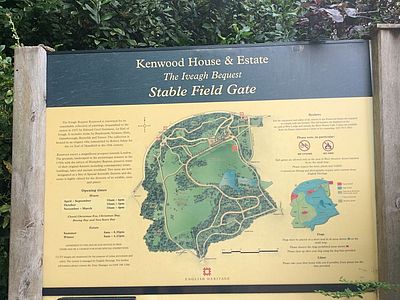
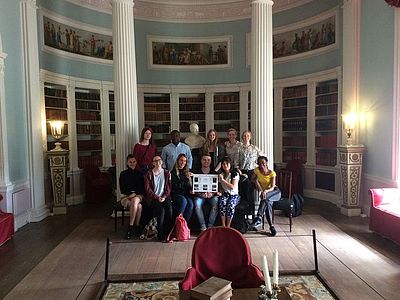
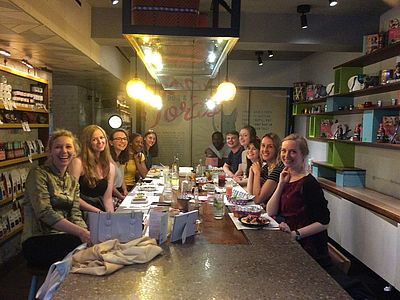 © Jana Nittel
© Jana Nittel
Theatre Reports
Student Review of Theatre Performances, written by Solomon Ugwuanyi: Andrea Levy’s Small Island at the National Theatre and William Shakespeare’s A Midsummer Night’s Dream at Shakespeare’s Globe Theatre
The two performances served as a practical crash course and an immersion into what the two extremes of theatre performances could be. While they had a few points of convergence, being that they were both live theatre performances, we would come to see a polar divergence in the dynamics of content and presentation.
Periods: Modern theatre represents all the evolution that classic theatre has undergone over the years. Andrea Levy’s Small Island’s performance at the National Theatrewas a contemporary theatre experience or what some texts call Modern Theatre, while William Shakespeare’s A Midsummer Night's Dream, aptly performed at Shakespeare’s Globe Theatre, is an effort at reproducing a classic Elizabethan stage experience. Similarities, differences, and general experiences will be reflected upon using the following feature points:
Costumes: Small Island (2004) is a relatively contemporary work compared to A Midsummer Night’s Dream, hence the more fashionable costumes worn by the performers. The costumes’ fine tailoring, delicate detailing and flawless finish suggest more than just how recent the work is. They also point to the elegance that has come to be associated with modern theatre. The same cannot be said of the costumes used to perform A Midsummer Night’s Dream. While they were neat and in some cases over the top, with embroideries and eclectic fabrics to indicate royalty, it was generally more simplistic. Again, while intentions are not clearly stated, the simplicity can be taken as an attempt at keeping the theatre experience as close as possible to the characteristic features of Elizabethan and Jacobean performances.
Ease of Access: The gulf between the ticket prices (£55 and £5, respectively), which also influences who can attend which performances, reinforces the idea that Elizabethan theatre was largely the people’s theatre and not an exclusive luxury meant for the wealthy. For this price, almost anyone can afford to attend theatre performances several times a week. The same cannot be said of spending £55 every other day, which then establishes that modern theatre may have morphed into an exclusive experience for the upper classes, or a once-in-a-while experience for low-income earners.
Props, Stage and Lighting: The modern play relied heavily on a contemporary staging with a revolving stage equipped with contraptions and spots that let things and people appear on and disappear from the stage without needing to walk on or off. This augmented the general effect of some scenes like Aunt Dorothy’s passing, which I imagine would have been cumbersome without these modern advantages, as the stage would have had to be darkened, with the actress tiptoeing off. Instead, the actress gradually disappeared under the stage while still choking. Other elements like the projectors and multiple lightings all come together to set it apart as a modern performance. The Globe Theatre performance, on the other hand, relied very minimally on such trappings and had actors running off and onto the stage. However, what it lacked in technological finesse it made up for in conviviality between the actors and spectators, since they were often running into, talking to, and touching spectators. This generally made it a more relaxed environment.
Audience-Cast Interactions: This must be one of the most glaring observations that anyone who attended both plays will have. The relationship between the actors and members of the audience was practically non-existent at the National Theatre; even monologues were done in a manner that suggested no acknowledgement of the audience’s presence. Conversely, the production at the Globe saw spectators as an integral part of the evening, ranging from directly speaking to members of the audience, through approaching the stage from where the spectators were seated or standing, down to even seeking assistance from the audience members to get off the stage. It was a most hilarious and engaging spectacle to behold, which once again emphasised the idea that the people are an integral part of the performance.
Gender Representations: One of the rather infamous chapters in the history of traditional theatre is its jarring underrepresentation of women on stage, resulting in male actors being cast as female characters. Thankfully, the Globe’s quest for preservation of the early theatre experience did not see producers retain this tradition. The performance, though traditional, had a healthy gender representation with roles being assigned in a very fluid manner, such as casting all mechanicals with female actors. Small Island’s performance was also well balanced, though it stuck to the gender roles as they were in the original text.
Conclusion: Altogether, both performances were extremely interesting experiences and unique in their own ways. This makes it pointless to say one was better than the other, since there would always be something in the one that would be missing in the other.
(Slightly edited by Darleen Helms and Nadine Schmidt for publication purposes.)

